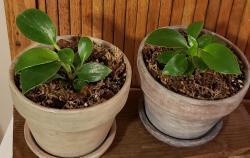Welcome
@pbgarden! We hope you will hang out with us! We are a small but dedicated band of aroiders!
I am not an expert on tissue culture by ANY means, but I have read some about it because after all, most of the commercially available plants are tissue cultures and have been for decades. (Makes you wonder why most endangered plants are endangered, huh? Maybe because they only produce what the market says is in demand. After all its TOO SLOW to propagate the old fashioned way...no MONEY in it)
But to my understanding, when a hybrid plant is tc'd, especially a variegated one, all of the genetic parents of that plant are present in what is called 'the culture'. One specimen may have a higher proportion of the genetic material of one plant somewhere way down the breeding line (many hybrid philodendrons and anthuriums are the product of very complex 'breeding lines' with generational crosses going back 5-10 plants), another plant may have a higher proportion of another. Most professional hybridizers and careful to keep track of all their crosses and perform the pollinations under sterile conditions, but not all. And most have enough working knowledge of the ploidy (the chromosomal matches) of different species to know which would tend to mesh seamlessly with each other, but not all. (some anthurium species in different sections will NOT cross pollinate, because their chromosomes are of a different number and don't match. Others will, but the resultant progeny can be highly variable and prone to odd quirks, like Anthurium Marie). And there has never been a successful extrageneric hybrid made between Anthurium and Philodendron.
And when these plants are 'grown out', they can either immediately express this genetic disproportion, or they may not express it at all. Or they may express it later, which seems to be what is happening in Birkin.
I know enough about hybridizing to know that when you cross two different species plants via the old fashioned method, (or hybrid plants) there can be a high degree of variability in the resultant progeny. This is how many new plants are 'discovered'....sometimes a single seedling will be seen to exhibit differences that are marked enough to warrant putting that one aside and propagating it by the old fashioned vegetative method, to see if the 'je ne said quo' sticks. If it does, they will patent that 'new, unique' plant and produce it. This also happens in batches of TC plants...sometimes an odd duck pops out.
I read also a long time ago that the reason it was so hard to tissue culture variegated monstera was that a high proportion of the seedlings turned out green because the original plants were all green, or only slightly variegated, and reverted, so that the process for a while was thought to not be applicable to reproducing that particular plant. The argument was that this is why they are so expensive, because they could only be reproduced by stem cuttings because the seeds do not produce variegated babies.
That seems to have been solved now, as the VM is in TC in numerous European and Asian TC houses and is being sold very cheaply overseas. If Costa Farms jumps on the bandwagon here, the price should drop dramatically. I also heard through the aroid grapevine that they have already had one total batch failure due to contamination, do not know if that is true but it resulted in the loss of an entire crop apparently.
